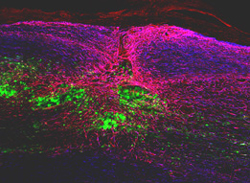Joost Verhaagen

The overall objective of the Laboratory for Neuroregeneration is to unravel the biological mechanisms that govern successful regeneration in the PNS and that underlie degeneration and regenerative failure in the CNS. The primary long-term research objective is to make significant contributions to the field of restorative neuroscience and neurology.

The overall objective of the Laboratory for Neuroregeneration is to unravel the biological mechanisms that govern successful regeneration in the PNS and that underlie degeneration and regenerative failure in the CNS. The primary long-term research objective is to make significant contributions to the field of restorative neuroscience and neurology.
The Laboratory for Neuroregeneration has 3 research lines:
Research line 1: Functional genomics: from target to therapy
Research line 2: Inhibitors of neuroregeneration: semaphorins
Research line 3: Gene therapy: a repair strategy for the injured CNS and PNS
For more information please click here
Bossers, K., Meerhoff, G., Balesar, R., Van Dongen, J., Kruse, C., Swaab, D.F., Verhaagen J. (2009) Analysis of gene expression in Parkinson’s disease: possible involvement of neurotrophic support and axon guidance in dopaminergic cell death. Brain Pathology 19: 91-107
Blits, B., Verhaagen, J. (2009) Gene therapy for neurological disease. Encyclopedia of Neuroscience (Springer) pp. 1682-1687
Verhaagen, J., Pasterkamp, R.J. (2009) Semaphorins. New Encyclopedia of Neuroscience (Elsevier) pp. 577 – 583.